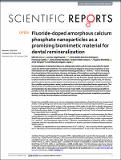Por favor, use este identificador para citar o enlazar a este item:
http://hdl.handle.net/10261/214193COMPARTIR / EXPORTAR:
 SHARE SHARE
 CORE
BASE CORE
BASE
|
|
| Visualizar otros formatos: MARC | Dublin Core | RDF | ORE | MODS | METS | DIDL | DATACITE | |

| Título: | Fluoride-doped amorphous calcium phosphate nanoparticles as a promising biomimetic material for dental remineralization |
Autor: | Iafisco, Michele; Degli Esposti, Lorenzo; Ramírez Rodríguez, Gloria Belén; Carella, Francesca; Gómez Morales, Jaime; Ionescu, A. C.; Brambilla, Eugenio; Tampieri, Anna; Delgado López, José Manuel CSIC ORCID | Fecha de publicación: | 19-nov-2018 | Editor: | Nature Publishing Group | Citación: | Scientific Reports 8: 17016 (2018) | Resumen: | Demineralization of dental hard tissue is a widespread problem and the main responsible for dental caries and dentin hypersensitivity. The most promising strategies to induce the precipitation of new mineral phase are the application of materials releasing gradually Ca and PO ions or mimicking the mineral phase of the host tissue. However, the design of formulations covering both processes is so far a challenge in preventive dentistry. In this work, we have synthesized innovative biomimetic amorphous calcium phosphate (ACP), which has been, for the first time, doped with fluoride ions (FACP) to obtain materials with enhanced anti-caries and remineralizing properties. Significantly, the doping with fluoride (F) did not vary the physico-chemical features of ACP but resulted in a faster conversion to the crystalline apatite phase in water, as observed by in-situ time-dependent Raman experiments. The efficacy of the as synthesized ACP and FACP samples to occlude dentinal tubules and induce enamel remineralization has been tested in vitro in human molar teeth. The samples showed good ability to partially occlude the tubules of acid-etched dentin and to restore demineralized enamel into its native structure. Results demonstrate that ACP and FACP are promising biomimetic materials in preventive dentistry to hinder demineralization of dental hard tissues. | Versión del editor: | http://dx.doi.org/10.1038/s41598-018-35258-x | URI: | http://hdl.handle.net/10261/214193 | DOI: | 10.1038/s41598-018-35258-x | Identificadores: | doi: 10.1038/s41598-018-35258-x e-issn: 2045-2322 |
| Aparece en las colecciones: | (IACT) Artículos |
Ficheros en este ítem:
| Fichero | Descripción | Tamaño | Formato | |
|---|---|---|---|---|
| Jaime_Gomez_ScientificReports8_17016.pdf | 2,77 MB | Adobe PDF |  Visualizar/Abrir |
CORE Recommender
PubMed Central
Citations
32
checked on 28-mar-2024
SCOPUSTM
Citations
88
checked on 08-abr-2024
WEB OF SCIENCETM
Citations
70
checked on 23-feb-2024
Page view(s)
120
checked on 15-abr-2024
Download(s)
171
checked on 15-abr-2024

